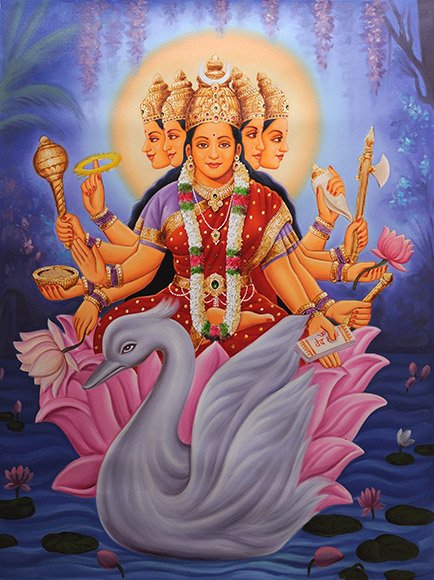Kaumudi, Kaumudī: 11 definitions
Introduction:
Kaumudi means something in Hinduism, Sanskrit, Jainism, Prakrit, the history of ancient India, Marathi. If you want to know the exact meaning, history, etymology or English translation of this term then check out the descriptions on this page. Add your comment or reference to a book if you want to contribute to this summary article.
In Hinduism
Purana and Itihasa (epic history)
Source: archive.org: Nilamata Purana: a cultural and literary studyKaumudī (कौमुदी) is another name for Āśvayujī Mahaḥ: a ceremony of new grains (performed in Āśvayujī) that once common in ancient Kashmir (Kaśmīra) as mentioned in the Nīlamatapurāṇa.—Āśvayujī Mahaḥ or Kaumudī is a festival celebrated in commemoration of Nikumbha’s return to Kaśmīra after killing the Piśācas dwelling in the sea of sand and continues for three days. The houses are decorated to welcome Nikumbha.

The Purana (पुराण, purāṇas) refers to Sanskrit literature preserving ancient India’s vast cultural history, including historical legends, religious ceremonies, various arts and sciences. The eighteen mahapuranas total over 400,000 shlokas (metrical couplets) and date to at least several centuries BCE.
Chandas (prosody, study of Sanskrit metres)
Source: Journal of the University of Bombay Volume V: Apabhramsa metres (2)Kaumudī (कौमुदी) is the name of a catuṣpadi metre (as popularly employed by the Apabhraṃśa bards), as discussed in books such as the Chandonuśāsana, Kavidarpaṇa, Vṛttajātisamuccaya and Svayambhūchandas.—Kaumudī has 14 mātrās in each of its four lines, divided into the groups of 5, 5 and [IIS] mātrās.

Chandas (छन्दस्) refers to Sanskrit prosody and represents one of the six Vedangas (auxiliary disciplines belonging to the study of the Vedas). The science of prosody (chandas-shastra) focusses on the study of the poetic meters such as the commonly known twenty-six metres mentioned by Pingalas.
In Jainism
General definition (in Jainism)
Source: archive.org: TrisastisalakapurusacaritraKaumudī (कौमुदी) is the name of a festival held on the full moon-day of the month Kārttika in honor of Kārttikeya.

Jainism is an Indian religion of Dharma whose doctrine revolves around harmlessness (ahimsa) towards every living being. The two major branches (Digambara and Svetambara) of Jainism stimulate self-control (or, shramana, ‘self-reliance’) and spiritual development through a path of peace for the soul to progess to the ultimate goal.
India history and geography
Source: Singhi Jain Series: Ratnaprabha-suri’s Kuvalayamala-katha (history)Kaumudī (कौमुदी) is the name of a festival (mahotsava) celebrated on the Śaratpaurṇimā in ancient India, according to Uddyotanasūri in his 8th-century Kuvalayamālā (a Prakrit Campū, similar to Kāvya poetry).—Page 103.15: Here is a reference of the Kaumudī Mahotsava celebrated in a the city of Campā on the Śaratpaurṇimā day (line 32). It was attended by great festivities of music, dance and drama. In the city-square a Naṭa gave demonstration of his dance. The Naṭa is called Bharata-putra, i.e., the follower of Bharata or an adept in Nāṭya-śāstra.

The history of India traces the identification of countries, villages, towns and other regions of India, as well as mythology, zoology, royal dynasties, rulers, tribes, local festivities and traditions and regional languages. Ancient India enjoyed religious freedom and encourages the path of Dharma, a concept common to Buddhism, Hinduism, and Jainism.
Languages of India and abroad
Marathi-English dictionary
Source: DDSA: The Molesworth Marathi and English Dictionarykaumudī (कौमुदी).—f S Moonshine or moonlight.
Source: DDSA: The Aryabhusan school dictionary, Marathi-Englishkaumudī (कौमुदी).—f Moonlight or moonshine.
Marathi is an Indo-European language having over 70 million native speakers people in (predominantly) Maharashtra India. Marathi, like many other Indo-Aryan languages, evolved from early forms of Prakrit, which itself is a subset of Sanskrit, one of the most ancient languages of the world.
Sanskrit dictionary
Source: DDSA: The practical Sanskrit-English dictionaryKaumudī (कौमुदी).—[kumudasyeyaṃ prakāśakatvāt aṇ ṅīṣ Tv.]
1) Moonlight; शशिना सह याति कौमुदी (śaśinā saha yāti kaumudī) Kumārasambhava 4.33; शशिनमुपगतेयं कौमुदी मेघमुक्तम् (śaśinamupagateyaṃ kaumudī meghamuktam) R.6.85; (the word is thus popularly derived :-kau modante janā yasyāṃ tenāsau kaumudī matā).
2) Anything serving as moonlight, i. e. causing delight and balmy coolness; त्वं कौमुदी नयनयोरमृतं त्वमङ्गे (tvaṃ kaumudī nayanayoramṛtaṃ tvamaṅge) Uttararāmacarita 2; त्वमस्य लोकस्य च नेत्रकौमुदी (tvamasya lokasya ca netrakaumudī) Kumārasambhava 5.71; या कौमुदी नयनयो- र्भवतः सुजन्मा (yā kaumudī nayanayo- rbhavataḥ sujanmā) Mālatīmādhava (Bombay) 1.34; cf. चन्द्रिका (candrikā).
3) The full moon day in Kārtika; तस्मात्तु कपिला देया कौमुद्यां ज्येष्ठपुष्करे (tasmāttu kapilā deyā kaumudyāṃ jyeṣṭhapuṣkare) Mahābhārata (Bombay) 13.13.32.
4) The full moon day in Āśvina.
5) Festivity (in general).
6) Particularly, a festive day on which temples, houses &c. are illuminated.
7) (At the end of titles of works &c.) Elucidation, throwing light on the subject treated; e. g. तर्ककौमुदी, साख्यतत्त्वकौमुदी, सिद्धान्तकौमुदी (tarkakaumudī, sākhyatattvakaumudī, siddhāntakaumudī) &c.
Source: Cologne Digital Sanskrit Dictionaries: Aufrecht Catalogus Catalogorum1) Kaumudī (कौमुदी) as mentioned in Aufrecht’s Catalogus Catalogorum:—in law, see Kṛtyakaumudī, Kriyākaumudī, Vratakaumudī, Śuddhikaumudī, Smṛtikaumudī.
2) Kaumudī (कौमुदी):—abridged from Jyotiṣkaumudī, Prakriyākaumudī, Saṃgītakaumudī, Siddhāntakaumudī.
3) Kaumudī (कौमुदी):—grammatical, quoted by Kṣīrasvāmin in Kṣīrataraṅgiṇī.
4) Kaumudī (कौमुदी):—a
—[commentary] on the Amarakośa. Quoted by Rāyamukuṭa, Bharatasena on Bhaṭṭikāvya 2, 13, Bhānujī Oxf. 182^b.
—by Nayanānanda Śarman. Io. 1161. Paris. (B 97).
5) Kaumudī (कौमुदी):—a
—[commentary] on Goyīcandra’s Saṃkṣiptasāraṭīkā, by Abhirāma Vidyālaṃkāra. Io. 1400. 1404.
6) Kaumudī (कौमुदी):—on the Amarakośa. read Bhaṭṭikāvya 2, 15.
Source: Cologne Digital Sanskrit Dictionaries: Monier-Williams Sanskrit-English Dictionary1) Kaumudī (कौमुदी):—[from kaumuda] a f. moonlight, moonshine (from its causing the Kumudas to blossom; also Moonlight personified as the wife of Candra or the moon), [Raghuvaṃśa; Kumāra-sambhava; Bhartṛhari] etc.
2) [v.s. ...] elucidation (the word Kaumudī being metaphorically used like other words of similar import cf. candrikā at the end of grammatical commentaries and other explanatory works to imply that the book so designated throws much light on the subject of which it treats e.g. padārtha-k, prakriyā-k, laghu-k, vaiṣamya-k, siddhānta-k)
3) [v.s. ...] the day of full moon in the month Kārttika (sacred to Kārttikeya), festival in honour of Kārttikeya held on that day, [Mahābhārata i, 7648; xiii, 6132; Purāṇa-sarvasva]
4) [v.s. ...] the day of full moon in the month Āśvina, [cf. Lexicographers, esp. such as amarasiṃha, halāyudha, hemacandra, etc.]
5) [v.s. ...] a festival in general, [cf. Lexicographers, esp. such as amarasiṃha, halāyudha, hemacandra, etc.]
6) [v.s. ...] (= kumud-vatī) the water-lily (Nymphaea esculenta), [Bhāgavata-purāṇa x, 65, 18]
7) [v.s. ...] a metre (of 2 x 24 syllables)
8) [v.s. ...] Name of a river, [Śaṃkara-vijaya]
9) [from kaumuda] b (f. of da q.v.)
Source: DDSA: Paia-sadda-mahannavo; a comprehensive Prakrit Hindi dictionary (S)Kaumudī (कौमुदी) in the Sanskrit language is related to the Prakrit word: Komuī.
Sanskrit, also spelled संस्कृतम् (saṃskṛtam), is an ancient language of India commonly seen as the grandmother of the Indo-European language family (even English!). Closely allied with Prakrit and Pali, Sanskrit is more exhaustive in both grammar and terms and has the most extensive collection of literature in the world, greatly surpassing its sister-languages Greek and Latin.
Kannada-English dictionary
Source: Alar: Kannada-English corpusKaumudi (ಕೌಮುದಿ):—[noun] the light of the moon; moon-light.
Kannada is a Dravidian language (as opposed to the Indo-European language family) mainly spoken in the southwestern region of India.
See also (Relevant definitions)
Starts with (+1): Kaumudicara, Kaumudichara, Kaumudijivana, Kaumudika, Kaumudimaha, Kaumudimahotsava, Kaumudimukha, Kaumudinirnaya, Kaumudipati, Kaumudiprabha, Kaumudipracara, Kaumudiprakasha, Kaumudirajani, Kaumudisara, Kaumuditaru, Kaumudivadana, Kaumudivarna, Kaumudividyavilasa, Kaumudivilasa, Kaumudivriksha.
Ends with (+115): Acarakaumudi, Adeshakaumudi, Adhikaranakaumudi, Agamakaumudi, Akalakaumudi, Amarakoshakaumudi, Anekarthakairavakarakaumudi, Arthakaumudi, Bandhakaumudi, Bhagavannamakaumudi, Bhagavatakaumudi, Bharatasutravritti sahityakaumudi, Bhashakaumudi, Bhasmakaumudi, Bhavakaumudi, Caturmasyakaumudi, Chandahkaumudi, Chandogyamantravyakhya mantrakaumudi, Chhandahkaumudi, Cikitsakaumudi.
Full-text (+457): Kaumudipati, Kaumudicara, Kaumudivriksha, Laghukaumudi, Sarasiddhantakaumudi, Nirmaladarpana, Nilakantha, Tirumalla, Varanavatesha, Kaumudivilasa, Madhyasiddhantakaumudi, Kaumudinirnaya, Kaumudipracara, Madhyakaumudi, Kaumudirajani, Kaumudimahotsava, Siddhantakaumudisara, Kaumudimaha, Kaumudiprabha, Siddhantakaumudikotipattra.
Relevant text
Search found 49 books and stories containing Kaumudi, Kaumudī; (plurals include: Kaumudis, Kaumudīs). You can also click to the full overview containing English textual excerpts. Below are direct links for the most relevant articles:
Sahitya-kaumudi by Baladeva Vidyabhushana (by Gaurapada Dāsa)
Text 10.276 < [Chapter 10 - Ornaments of Meaning]
Text 1.2 < [Chapter 1 - The Purpose of Poetry]
Source References < [Introduction]
Bhakti-rasamrta-sindhu (by Śrīla Rūpa Gosvāmī)
Verse 3.2.2 < [Part 2 - Affection and Service (dāsya-rasa)]
Verse 3.5.18 < [Part 5 - Conjugal Love (mādhurya-rasa)]
Verse 3.3.99 < [Part 3 - Fraternal Devotion (sakhya-rasa)]
Brahma Sutras (Nimbarka commentary) (by Roma Bose)
Brahma-Sūtra 1.2.29 < [Adhikaraṇa 7 - Sūtras 25-33]
Brahma-Sūtra 1.1.14 < [Adhikaraṇa 6 - Sūtras 13-20]
Brahma-Sūtra 1.3.8 < [Adhikaraṇa 2 - Sūtras 8-9]
A History of Indian Philosophy Volume 2 (by Surendranath Dasgupta)
Part 24 - Rāmādvaya (a.d. 1300) < [Chapter XI - The Śaṅkara School of Vedānta (continued)]
Part 22 - Philosophy of the Prakaṭārtha-vivaraṇa (a.d. 1200) < [Chapter XI - The Śaṅkara School of Vedānta (continued)]
Part 7 - The Stage of the Saint (Jīvan-mukta) < [Chapter XII - The Philosophy of the Yogavāsiṣṭha]
Preceptors of Advaita (by T. M. P. Mahadevan)
Amarakoshodghatana of Kshirasvamin (study) (by A. Yamuna Devi)
Commentaries on Amarakośa < [Chapter 1 - Kośa Literature–A Brief Survey]
Avyayas or Indeclinables < [Chapter 6 - Grammatical Aspects]
Related products
